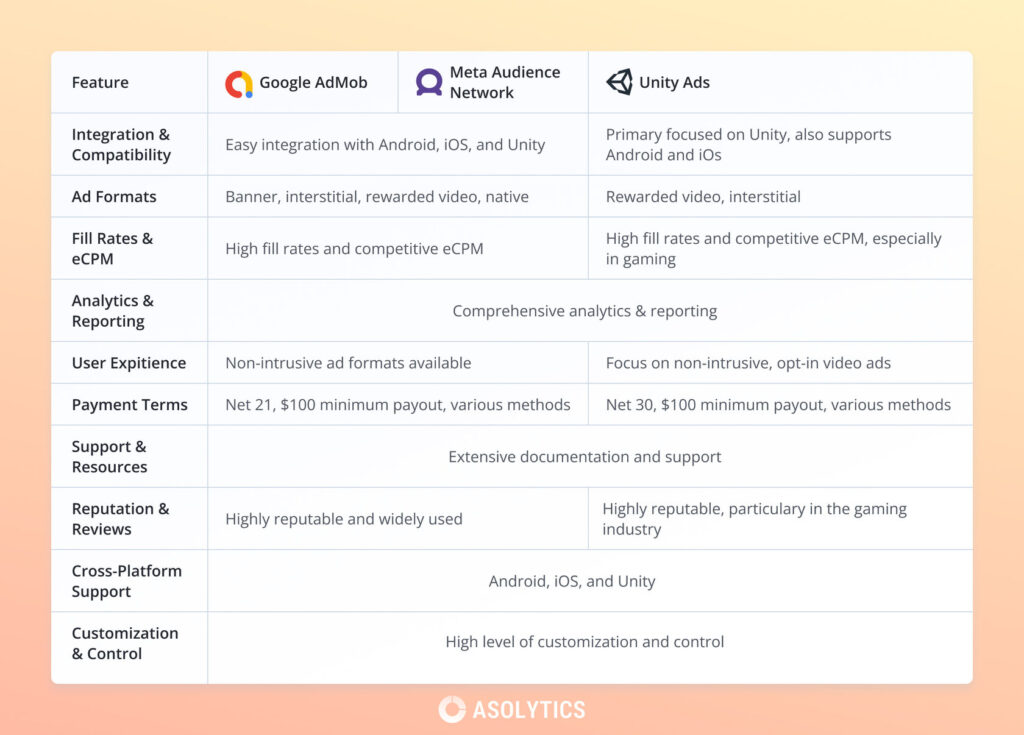According to Statista, global app revenue could exceed $600 billion by 2025. If you are a developer or publisher, you can access your part of the profit by choosing an app monetization platform. These services are designed to boost user engagement, enhance marketing effectiveness, and ultimately, increase revenue.
In this article, we’ve compared the top 3 highest-rated app monetization platforms and also consulted chatGPT for its recommendations. Read on to find out if our conclusions align. First, we’ll dive into the specific functions of app monetization platforms and the crucial factors to consider when making a decision. Then, we’ll provide a detailed comparison of the top 3 platforms.
Table of Contents
What App Monetization Platforms Do
App monetization platforms help app developers and publishers generate revenue from their apps through various strategies such as in-app advertising, in-app purchases, subscriptions, and more. These platforms provide the tools, resources, and support needed to effectively implement and manage monetization strategies.
Here are some specific examples of what mobile app monetization platforms do:
- In-app advertising
The platform provides an ad network or ad mediation solution that enables app developers to display ads within their apps. These ads can be in various formats like banners, interstitials, rewarded videos, or native ads. App developers earn revenue based on the number of ad impressions, clicks, or completed views.
Examples: AdMob by Google, MoPub by Twitter, and Facebook Audience Network. - In-app purchases (IAP)
The platform helps developers integrate in-app purchases, allowing users to buy digital goods or services within the app. Developers can offer one-time purchases, consumable items, or non-consumable items.
Examples: Google Play In-app Billing, Apple’s StoreKit for iOS apps. - Subscriptions
The platform provides tools to set up and manage subscription-based pricing models. This allows users to access premium features, content, or services on a recurring basis (e.g., monthly or yearly).
Example: RevenueCat, which simplifies subscription management across different app stores. - Offerwalls and surveys
The platform allows developers to incorporate offerwalls or surveys within their apps. Users can complete tasks, offers, or surveys in exchange for in-app rewards or virtual currency. This creates an additional revenue stream for app developers.
Examples: Tapjoy, Fyber, and ironSource. - Data monetization
The platform helps app developers monetize their user data by providing insights and analytics. This data can be used to create targeted advertising campaigns or improve app features, resulting in increased user engagement and revenue.
Examples: AppsFlyer, Adjust, and Kochava. - Affiliate marketing
The platform enables developers to promote third-party products or services within their apps, earning a commission for each successful refer a friend programs, purchase, or sign-up.
Examples: Amazon Associates, Commission Junction, and Impact Radius. - Sponsorships and partnerships
Some platforms help developers connect with brands or advertisers to create sponsorship deals, sponsored content, or branded in-app experiences. These collaborations can provide additional revenue streams for both parties.
Examples: AppLift, Chartboost, and Vungle.
By leveraging these app monetization platforms and their various strategies, app developers and publishers can maximize their revenue potential while offering a seamless user experience.

But how do you find the right app monetization platforms? We decided to compile the top three platforms using ChatGPT and then compare the received data with the reviews and ratings of real users. However, first, let’s figure out how to compare monetization platforms with each other to evaluate the test results.
How to Compare Mobile App Monetization Platform
To find the best app monetization platform for your product, you need to know what to look for first.
Integration and compatibility
A platform should be compatible with your app’s development framework. Various services have different requirements and limitations when it comes to third-party SDKs.
Ad formats
A good app monetization platforms should offer various ad formats, such as banners, interstitial ads, native ads, and rewarded videos so that you can choose the most effective format for your target audience.
Fill rates and eCPM
High fill rates (the percentage of ad requests successfully filled with an ad) and eCPM (effective cost per thousand impressions) are crucial for maximizing revenue.
Analytics and reporting
A platform should provide detailed reporting and analytics to help you track your app’s performance and optimize your Android and iOS app monetization strategy. Look for a service that offers real-time reporting, user-level analytics, and other useful metrics.
User experience
Monetization instruments should have a minimal impact on your app’s user experience. Intrusive, low-quality, or irrelevant ads can lead to user churn and negatively impact your app’s reputation.
Payment terms
Look for a platform that offers flexible payment terms, such as monthly or bi-weekly payments, and supports multiple payment methods. When examining payment terms, always keep in mind your expenses, e.g., spending on developing new features or the App Store cost.
Support and resources
Look for platforms that provide clear documentation, responsive customer support, dedicated account managers, and guidance on how to integrate them seamlessly.
Reputation and reviews
Consider a platform’s reputation and read reviews from other developers who have already used it. Look for a service with a good track record of delivering high-quality ads, generating solid revenue, and providing excellent support.
Cross-platform support
If you have apps that run on multiple platforms (iOS, Android, etc.), cross-platform support can be an important factor to consider. Such a tool will simplify monetization and help you make the mobile app monetization strategy consistent.
Customization and control
A good platform should offer a high level of customization and control over ad placements, design, targeting, and frequency, allowing you to tailor the ad experience to your app’s specific needs.
Top 3 Best App Monetization Platforms
We researched various rating platforms and selected the top three platforms based on real users’ ratings:
- Google AdMob,
- Meta Audience Network,
- and Unity Ads.
We were curious to see if ChatGPT would suggest the same platforms. Having previously tested ChatGPT for app marketing and ASO tasks for Google Play and the App Store, we asked it to identify the top-rated platforms and provide the three most highly-ranked options.
The ChatGPT results matched our findings! Our experts took many rating platforms and their own experience into account while ChatGPT retrieved information from a massive datastore – and we were on the same page! Here’s what the AI recommended:

Three chosen platforms are worth focusing on for now. While they share similar purposes, they also have their differences. To choose the best one, you need to define your objectives and consider your app’s unique features.
To help you decide, we’ve compiled a comparison of Google AdMob, Meta Audience Network, and Unity Ads based on ten essential features mentioned earlier:

Let’s take a closer look at each platform separately and highlight their main features.
Note: The choice of a platform should align with your overall marketing strategy. To understand what exactly will be effective in your app, discover app market trends using Asolytics’ Store Chart. You can see which apps are popular right now and dig deeper into their monetization models to get valuable insights.
Google AdMob
Let’s start with the definition of “What is Google AdMob?” It is a service by Google that helps monetize mobile apps through in-app ads. You can select from a variety of ad formats, including banners, interstitials, and rewarded videos.
The platform features ad mediation, which automatically chooses the best ad network to display ads based on factors like eCPM and fill rate. Also, it has extensive targeting options, such as location-based and demographic targeting, which help deliver more relevant ads compliant with Apple and Google Play policies and improve engagement rates.
AdMob provides real-time reporting with tables and charts on ad performance, enabling developers to track metrics like impressions, match rates, clicks, and earnings. This data can be utilized to optimize ad placement and boost profits. The platform can also be integrated with other Google services, such as Google Analytics, AdWords, and AdSense, offering further insights into user behavior and helping to enhance app performance.
Key features:
- ad mediation to work with several networks at once;
- lots of options for ad personalization;
- extensive documentation;
- integration with Google services.
Facebook Audience Network
You might wonder “What is Facebook Audience Network?” It is another top-rated service that provides app monetization tools for mobile app developers. Just like AdMob, it offers a range of ad formats, including native, interstitial, and rewarded video ads, which can be customized to match the design of a particular app.
Audience Network has advanced targeting tools based on Facebook’s user data, which helps you deliver more relevant ads to your potential clients. As a good ad platform, it provides real-time reporting on ad performance, e.g., impressions, clicks, and overall revenue, allowing developers to optimize their mobile app monetization plan.
Meta Audience Network has a real-time ad auction system that ensures that the highest-paying ads are displayed to users. It’s based on their own Vickrey-Clarke-Groves approach and significantly varies from Google’s generalized second-price system. Of course, the platform can be integrated with Facebook’s advertising ecosystem, which allows developers to run ads across both Facebook and Audience Network easily.
Key features:
- data is pulled from Facebook;
- extensive targeting options;
- branded ad auction system;
- integration with Facebook.
Unity Ads
Unity Ads is the third top-rated platform for monetizing mobile products, primarily games. It offers all the same tools as its counterparts from Google and Facebook: a vast set of various ad formats, precise targeting, reports in real-time mode, and so on. At the same time, this platform is unique in its own way, as it has features that are especially useful for mobile game developers.
Unity Ads is fully integrated with the Unity game engine. It makes it easy to manage ads within projects and ensure they are inserted seamlessly into the gameplay. While Facebook and Google offer advanced audience targeting, Unity Ads has some unique options specifically designed for mobile games.
For example, you can target a Unity Ads banner based on the type of game being played, the level of a player, or the player’s in-game behavior. Also, it provides a range of monetization tools designed for this category, such as rewarded video ads that give users in-game bonuses.
Key features:
- integration with the Unity engine;
- unique targeting options;
- exclusive mobile game monetization tools.
Choosing the Right App Monetization Platforms
App monetization is an essential stage of app development and promotion, so the choice of an efficient app monetization platforms is of key importance for generating income. The decision about a specific platform directly depends on the goals, needs, app features, and app monetization models. To summarize our overview, we’d like to point out that Google AdMob offers the widest choice of ad formats and provides the most detailed reports and analytics. Meta Audience Network has a more extensive set of targeting options than similar services. In turn, Unity Ads is ideal for monetizing mobile games as it offers unique tools for this segment.
All three platforms selected by ChatGPT and our experts provide developers with extensive supporting documentation, making the process of using and integrating them convenient and simple. However, we still recommend that you test the capabilities of each of them on your own to choose the one that really suits your monetization needs.




